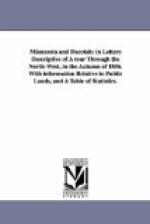Of the country above Crow Wing, he makes the following observations, which are not less interesting than instructive: “Over the whole route which I traversed after leaving Crow Wing River, the country has a different aspect from that which the banks of the Mississippi above the falls present. The forests are denser and more varied; the soil, which is alternately sandy, gravelly, clayey, and loamy, is, generally speaking, lighter excepting on the shores of some of the larger lakes. The uplands are covered with white and yellow pines, spruce and birch; and the wet lowlands by the American larch and the willow. On the slopes of sandy hills, the American aspen, the canoe birch (white birch), with a species of birch of dwarfish growth, the alder, and wild rose, extend to the very margin of the river. On the borders of the larger lakes, where the soil is generally better, we find the sugar maple, the black and bar oaks (also named overcup white oak, but differing from the white oak), the elm, ash, lime tree, &c. Generally speaking, however, this woodland does not extend back farther than a mile from the lakes. The white cedar, the hemlock, spruce, pine, and fir, are occasionally found; but the red cedar is scarce throughout this region, and none, perhaps, are to be seen but on islands of those lakes called by the Indians Red Cedar Lakes. The shrubbery consists principally of the wild rose, hawthorn, and wild plum; and raspberries, blackberries, strawberries, and cranberries are abundant.
“The aspect of the country is greatly varied by hills, dales, copses, small prairies, and a great number of lakes; the whole of which I do not pretend to have laid down on my map. * * * * The lakes to which I have just alluded are distributed in separate groups, or are arranged in prolonged chains along the rivers, and not unfrequently attached to each other by gentle rapids. It has seemed to me that they diminish in extent on both sides of the Mississippi, as we proceed southwardly, as far as 43 degrees of north latitude; and this observation extends to the Arctic region, commencing at Bear’s Lake; or Slave Lake, Winnipeg Lake, &c. It may be further remarked that the basins of these lakes have a sufficient depth to leave no doubt that they will remain characteristic features of the country for a long time to come. Several species of fish abound in them. The white fish (Corregonus albus) is found in all the deep lakes west of the Mississippi— and, indeed, from Lake Erie to the Polar Sea. That which is taken in Leech Lake is said by amateurs to be more highly flavored than even that of Lake Superior, and weighs from three to ten pounds.* * * Of all the Indian nations that I have visited, the Chippewas, inhabiting the country about the sources of the Mississippi, are decidedly the most favored. Besides their natural resources (to which I have already referred) of fish, wild rice, and maple sugar, with the addition of an abundance of game, the climate is found to be well adapted to




